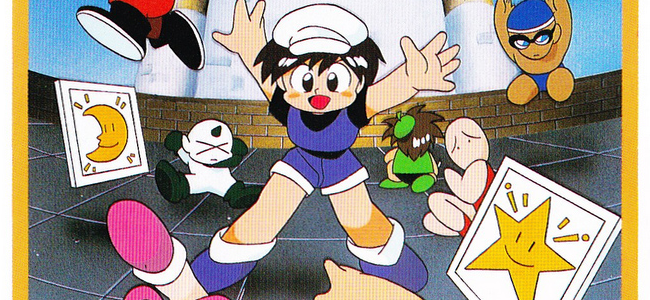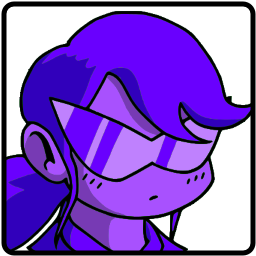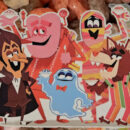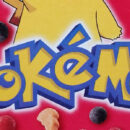Quinty, known as Mendel Palace in the West, was the first game released by GameFreak. You know, those guys who went on to make Pokémon. This game is nothing like that, though, aside from stylistic similarties in its graphics and music. This is an action puzzler for the NES, the likes of which, I believe, have not been seen before or since its release.
For the purposes of this review, I’ll be discussing the gameplay in terms of the Western release, because that is the only copy I have access to. As far as I’m aware, this version had some altered stages and AI, so it’s only fair to judge the game by this particular variant. Aesthetically, though, I much prefer the Japanese version. The story in the Western release (Mendel Palace) was changed to some boring rehash of the “save the princess” plot, because of course it was. The characters’ names were changed to some really stupid ones which I won’t even bother to state here. The title screen was changed to some “gritty” artwork which, while well-done, completely eschews the tone of the whole game.
In the original Quinty, though, the story is this: The protagonist, Carton, falls in love with a girl named Jenny. His older brothers and sorceress sister, Quinty, get jealous and kidnap her, sending an army of living dolls to cause him mischief. See, this plot has just the right amount of absurdity and whimsy to make it stand out. It really didn’t need to be changed, but thanks, 80’s-90’s Nintendo of America, for trying to make every game look the same and for ensuring that Kirby always has angry eyebrows.
As a personal preference, I will be referring to the characters and story of the original plot.
Alright, so let’s get to the gameplay. It’s pretty simple and easy to understand, which, as you may have noticed in the previous games I’ve reviewed, is something I regard quite fondly. Carton can move about in four directions, and pressing the A button will shuffle the panel directly in front of you. Any player or enemy standing on top of the shuffled panel will be thrown forward. Your objective is to destroy all of the enemies in each round, primarily by shuffling them into walls, which destroys them. There are other methods of attack, but I’ll get to them later.
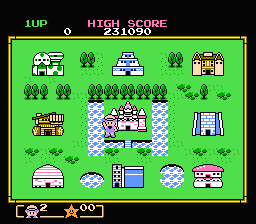
The nine main stages on the world map.
The game is broken down into nine main stages, each with its own special gimmick enemy. For example, the first stage has Walk Men, which just follow the player around, while the second stage has Jumpers, which move by jumping, avoiding your attacks while airborne. The enemies sound basic – just one type per round? – but it really works on a fundamental level, especially as variants of each enemy are introduced. In later rounds of the first stage, Walk Men move faster, or split into two smaller Walk Men when shunted away. In the second stage, multiple variants of the Jumper appear, some making smaller, faster jumps, others practically moon-jumping between panel centers. The game really keeps you on your toes, introducing new yet familiar challenges and forcing you to play in different ways without overwhelming you with numerous enemy types. In one stage, you’ll even face off against enemies who only move when you move and who shuffle panels whenever you do, which puts an unexpected strategy-esque spin on things.
The tenth round of each stage is either a cutscene or a boss, which may be a group of enemies or one single, special enemy. Some bosses will even change you into various enemy types, which is pretty neat, but most of them are pushovers who just hop over you, back and forth, asking for punishment. Strangely, Mendel Palace changed a bunch of the bosses from Carton’s brothers into Quinty, which, I guess, that’s fine, no need for bosses that look different or anything, sure. They also made the decision to change Quinty’s magic so that she can only turn Carton into enemies that appeared in the current stage, which is… less forgiveable. But whatever.
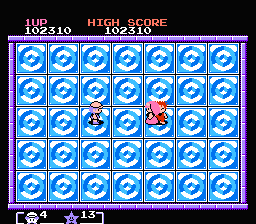
Carton’s brother Plum abducts Jenny in the first “boss” round.
Now, I stated that shuffling a panel beneath an enemy will send it hurtling backward. When I said “shuffling”, I literally meant shuffling – like a deck of cards. Each tile in the stage is actually a stack of panels. Shuffling one panel will send whatever is at the top to the bottom, revealing the next panel. While every stage is comprised of the same 7×5 panel grid, stage layouts differ not only in which enemies are present, but in the stacks of panels. Aside from the Normal Panel (floors), there are Metal Panels, which act as walls that can be shuffled away or broken by certain enemies, Cross Panels, which shuffle lines of panels in a cross shape when touched, Sun Panels, which shuffle all the panels in the stage, Attack Panels, which send Carton flying forward, destroying any enemies in his path, Rock Panels, which acts as floors but can never be shuffled again, and many more.
By far the most dangerous panel in the game is the Enemy Panel, which generates one new enemy. There will be times when you step on a Cross (or, by some tragic misstep, a Sun), or panel-shuffling enemies wreak havoc, and a whole slew of Enemy Panels will show up, and you’ll just have to figure out how to deal with them. Only a certain number of enemies may appear on screen at once, but as soon as you eliminate them, more will just keep spawning. Nothing compares to the horror that is the eighth round of the final stage. I’ll just let you discover that on your own, whether by playing the game or watching somebody else do it.
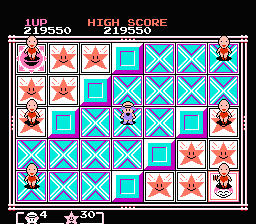
A typical round opening, featuring Ballerinas, Metal Panels, Star Panels, and a dangerously tempting Sun Panel. Who knows what lies beneath the surface?
The large variety of interactable panels, presented in lots of interesting combinations, further ensures that the game doesn’t become boring. One of the most interesting ways to clear a stage in the game is by, in certain rounds, shuffling all the panels until they become unusable Rock Panels. This causes Artist enemies, which attack by drawing on usable panels, to just lie down, give up, and die. Holy shit.
Make no mistake: This game can get hard. Between the increasingly-treacherous stage layouts, traps, enemies that are too heavy to shuffle, enemies that shuffle you, and lots of other compounding factors, you’ll likely be getting a lot of game overs on your first run. Supposedly, it’s a lot easier in the 2-player mode, though I’ve never tried it myself. Or, if you’re completely insane, there’s a sort of “second quest” you can access which gives you one hundred new, harder stages, with no continues if you lose all of your lives.
The game is not without its imperfections, though. Scattered about each stage, often shuffled beneath other panels, are Star Panels. They seem pretty important at first, because if you collect 100 of them, you get another life. Don’t be fooled, though. Lives are more of a formality than anything else in this game. If you run out of lives, you’re booted back to the title screen, from which you can choose to continue the game. Doing so will strip you of your high score and reset your lives back to two (that’s three lives), but all the progress you’ve made thus far will be saved, including which round you were on in each stage. So, even if you’re having difficulty with a particular stage, you are afforded the opportunity to retry over and over again without having to repeat any stages you’ve already cleared. I suppose that this mitigates the general difficulty of the game, but it makes the lives system seem like just another pointless holdover from arcade days.
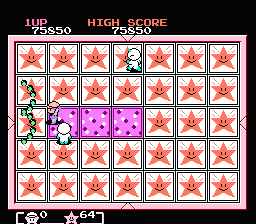
This round has a lot of Star Panels, but there’s no real need to collect them all.
You may be thinking that the Star Panels would come in use during the hard mode, but they’re actually nerfed in that mode – the only way to get extra lives in hard mode is by amassing points. Understandably, this makes the game even harder, but it leaves the Star Panels feeling somewhat useless unless you’re the rare type of player who actually cares about high scores in NES games. All I’m saying is, if you’re going to implement a life system, it probably ought to mean something more than just an impediment to achieving a better score.
Despite this oddity, I feel that the controls are actually the weakest part of the game. Don’t get me wrong – the game’s engine is definitely polished. My problem here doesn’t have anything to do with programming errors, it’s in the design. When you move your character, he will always take a minimum amount of steps forward which is larger than what is expected for an action game like this. Furthermore, if you turn, you’ll be delayed, standing still for a moment while you reposition yourself, and if you need to turn 180 degrees around to face the other direction, this delay is considerably greater. All of this is clearly intentional. Perhaps the idea was to make the game more “chess-like”, for lack of a better term – like how The Legend of Zelda is restricted to a grid.
My basic gripe is that it causes the player to make unnecessary mistakes – stepping too far with one press of a button, shuffling the wrong panel – even, sometimes, the panel you’re standing upon – because you can’t easily move into the optimal position, and so on and so forth. This is especially evident when trying to use Attack Panels. If Carton is off-center, or the opposing enemy is off-center, Attack Panels become completely useless as he just whizzes by the dolls to no effect. Carton must be in the precise center of an Attack Panel in order to use it, which means that the opposing enemy must also be lined up. Given that enemies have a habit of walking between panels, this is rather difficult to pull off, making those panels much more of a nuisance than anything else. Unless, of course, you abuse them by bouncing between two repeatedly, waiting for enemies to line up for slaughter.
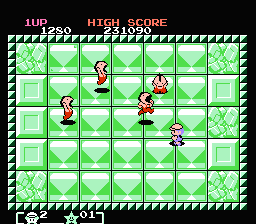
A group of Jumpers gangs up on Carton.
With all this being said, my complaints should be considered suggestions for improvement more than anything else. They don’t greatly impede my enjoyment of the game. On the contrary, it is my opinion that this game should serve as a particularly good example for developers, because it manages to craft its own, almost wholly unique style of gameplay quite cleverly without being too obtuse.
Unfortunately, there never was another Mendel Palace, and it quickly faded into obscurity. It saw one re-release in 2014, in Japan’s Wii U Virtual Store, but that’s the extent of it. It’s sad, really. There’s so much more that could have been done with a concept like this, and, with further tweaking, any perceived shortcomings of the game could have been fixed or generally mitigated in subsequent versions. For now, all we have is this one forgotten gem.
Mendel Palace is available for the NES, and Quinty is available for the FC and Wii U Virtual Store (Japan only).
h/t: Hardcore Gaming 101, Gravy (Japanese manual scans), and Quinty Perfect Victory Guide.
